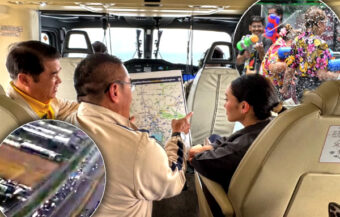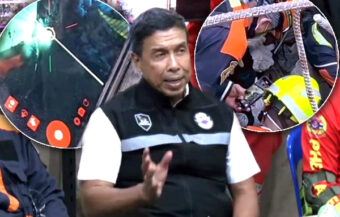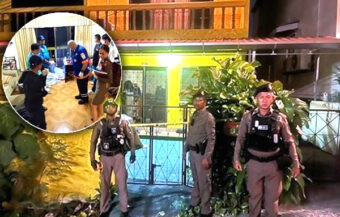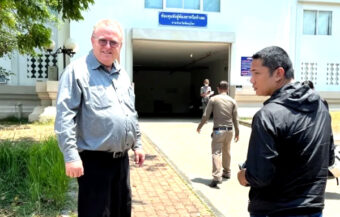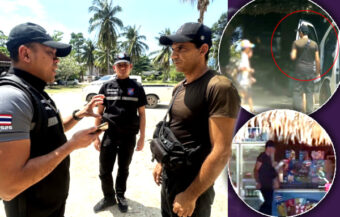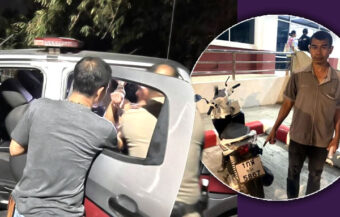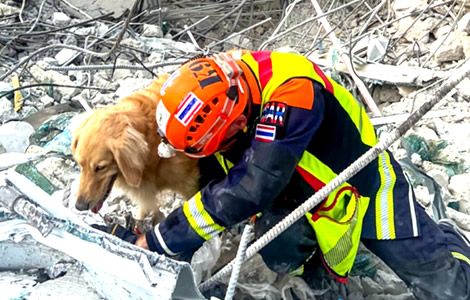Junta regime on the brink. Karen soldiers lower and burn the Myanmar flag in Myawaddy, dealing a major blow to General Min Aung Hlaing, the tyrant of Nay Pyi Taw as his military struggles against growing and popular rebellion against the February 2021 coup d’état.
The revolution in Myanmar against the brutal junta regime took a huge step forward in the last week. On Monday, Karen soldiers pulled down the despised Myanmar flag only introduced in 2010 by the military. In short, they burned it and replaced it with a blue, white and red Karen Union flag. The fall of Myawaddy was completed at the end of the week. It came when the 275th Battalion was routed under rocket, drone and grenade attack, further weakening the junta. Its already cratered economy lost a key border trading point which, in turn, puts pressure on supplying Yangon, the country’s main city.
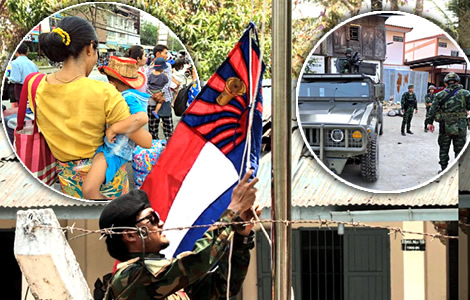
In addition to this, the Myanmar Air Force came under attack in Nay Pyi Taw, the junta’s purpose-built capital while rebel forces in Rakhine State went on the offensive. They announced a ‘decisive’ battle for a key port city and market town in the western state.
On Monday, in a particularly important signal, Karen military personnel raised the state flag over Phasong Army base. This was just 5 km from the Thai border with Mae Sot.
It fell just days before when the last junta battalion was left routed near the Thai border.
Military offensive launched in Rakhine State by the powerful Arakan Army chief to take a strategically important port city and market town just announced
It came in a week which saw the junta face an unprecedented drone attack at the heart of its power.
The Myanmar air base in Nay Pyi Taw came under heavy fire. A number of aircraft were damaged as well as hangar facilities.
At the same time in Rakhine State, Western Myanmar, the powerful Arakan Army put the junta on notice for further bad news.
The renowned military force is led by Twan Mrat Naing. In brief, he advised residents of Sittwe and Kyauk Phyu to move out.
He promised a ‘decisive’ battle in short order. The port city of Sittwe has a population of 147,899 while Kyauk Phyu is a major town of 20,866 people.
Meanwhile, in Bangkok, analysts were taken aback by the fall of Myawaddy.
Certainly, this became clear after a combined force of the National Unity Government’s People’s Defence Armed Forces (PDF) and the forces of the Karen National Union (KNU) opened fire on the last junta forces in the region.
That was at 4 am on Wednesday morning last.
275th battalion of the junta’s military, the Tatmadaw, expected to surrender before they were routed by rebel forces in an onslaught from Wednesday morning
The 275th Battalion had been expected to surrender and was in talks with the rebel forces.
However, early on Wednesday the last junta military base came under heavy mortar, drone and grenade fire from a powerful enemy force.
Despite calling in military strikes from the junta’s air force, Phasong camp was later abandoned.
Crumbling Burmese junta sends a plane to Tak to rescue retreating soldiers. They failed to show up as rebels advance
Approximately 200 troops sought refuge near a bridge adjacent to the Thai border. Following this, the force came under heavy drone attack on Friday from the National Unity Government’s forces.
Dulyapak Preecharush, associate professor of Southeast Asian Studies at Thammasat University, predicted that Myanmar’s military government would strike back, however.
In short, he pointed out its need to maintain control of strategic town centres. In addition, routes that are significantly important for economic and military reasons.
Fall of Myawaddy is a disaster for the Junta
The fall of Myawaddy is a disaster for the junta according to Professor Dulyapak.
He certainly predicted the junta would be forced to attempt to retake the town. This is because of its impact on supplying Burma’s largest city Yangon.
‘The town of Myawaddy is the gateway of the eastern border, so control of the town can have influence over the economy and livelihoods of people in Yangon. The military government will retake the town if it falls into the hands of any opposing group,’ he explained on Thursday.
‘We can assume that battlefields will centre around strategic routes and border towns. The ethnic groups will be at an advantage when collaborating with the anti-coup People’s Defence Forces (PDF),’ Professor Dulyapak outlined.
Thai government appears to be altering course in the light of a failing junta regime now laid bare by the fall of Myawaddy near Thailand’s border in Tak
Nevertheless, the Thai government appeared to be altering course since the fall of Myawaddy.
At length, Prime Minister Srettha Thavisin made it clear that Thai airspace would be certainly closed to the junta. This came despite permission for a flight into Tak Airport the week before.
In addition, however, the Foreign Affairs Ministry in Bangkok suggested it was time for the hated junta to alter course.
In effect, General Min Aung Hlaing must climb down and negotiate.
It was suggested that Thailand may support a resurrection of the failed 2021 ASEAN plan. In brief, this called for dialogue between the junta and the National Unity Government.
Previously, General Min Aung Hlaing ruled this out.
The Tatmadaw leader, at this time, is a reviled international pariah subject to international sanctions. He previously described the elected National Unity Government as ‘terrorists’.
Move Forward Party leader Pita Limjaroenrat urges Ministry of Foreign Affairs and government to allow access to National Unity government-aligned figures
Furthermore, the Move Forward Party’s Pita Limjaroenrat intervened again on the issue on Friday.
Mr Pita said he has spoken to representatives of the National Unity Government at recent conferences. He pointed out that access to the Thai government including Minister of Foreign Affairs Parnpree Bahiddha-Nu-Kara was not taking place.
In addition to the foreign minister, this applied to 14-15 senior Thai officials. Consequently, he suggested it was time for the Thai government to broaden its dialogue.
Mr Pita called for the government to balance its position on Burma to include the emerging power in the country. Channels of communication must be opened.
Dramatic flag-lowering highlights Myawaddy’s fall
On Monday, it was a moment of drama in the Thai-Myanmar border area.
Karen soldiers are a key ethnic minority group in Myanmar fighting with the National Unity Government.
Officers removed the Myanmar flag located at the former 275th Battalion headquarters in Myawaddy. Thereafter, it was replaced with the red, white and blue flag of the Karen National Union (KNU).
The green, yellow and red flag, only introduced in October 2010, was pulled down unceremoniously and burned.
The ceremony gives some idea of what may be in store for a new Burmese future.
Notably, the military’s name for the federation of Myanmar was only introduced in 1989. In short, this may be reversed.
After the revolution, Myanmar’s identity may again revert to Burma as it was widely and previously known before the army’s nationalistic renaming in 1989
The United States and many within Burma still used the older term. In its place, the country may become a looser federation, also called Burma, with strong autonomous states.
Furthermore, the capital may be returned to Yangon. The military’s purpose-built capital Nay Pyi Taw may not be a fitting centre of power for a new democratic Burma.
A key question will be the potential disbandment of the hated Tatmadaw, the now-reviled military. In short, the military force has disgraced itself and lost the confidence of the population.
This for many will be considered a sine qua non of the current revolution.
At the same time, more powerful autonomous independent states may emerge.
This revolution, supported by Burma’s youth, is primarily focused on democracy and a progressive economy.
Old ethnic dividing lines have been forgotten as well as ultra-nationalism.
Public in Burma never accepted the military junta regime as legitimate after an overnight coup d’état on February 1st 2021. The conflict grew from there
Sunday’s ceremony, of course, was a significant moment in the ongoing struggle between the Myanmar military junta and the ethnic minority Karen group.
Since the military coup in 2021, Myanmar has been embroiled in intense internal conflict.
A growing and increasingly powerful resistance force has been wearing down the military regime. Indeed, the junta never gained public acceptance after the February 1st overnight coup d’état in 2021.
As the conflict in Myanmar intensifies, the Thai-Myanmar border area has become a focal point of concern for Thailand.
The strategic border town of Myawaddy, located opposite Mae Sot District in Tak Province, is a key trading outpost.
It has now been seized by anti-junta forces with the junta struggling to establish another crossing. In short, it is fighting to preserve trade access.
Loss of Myawaddy is strategically important, the junta is losing economic power as well as territory and military capability. The trend leads to collapse
Border trade to the Myanmar junta is of heightened importance. This is due to its reliance on Thailand and severe international sanctions. Reports suggest that the Tatmadaw is already short of supplies as well as manpower.
Undoubtedly, failing economic power will cripple urban centres, the military’s operational ability and ultimately collapse the regime.
The fear for the junta is that it is losing economic control in line with military losses on the ground.
The regime in October 2023 saw setbacks in northern Shan State while its rank and file numbers have been crumbling.
Undoubtedly, this was behind hamfisted attempts at wider conscription including older men to the force in recent months.
Nevertheless, it lacks popular support. Defections and desertions from the morale-stricken ranks are growing. Similarly with the decimated Myanmar police force.
Reports suggest that senior officers in both forces are trying to exit the country, in particular, into Bangladesh and India.
Thailand has opened its borders to 4,000 Burmese people a day amid tight security. The government also firmly closed its airspace to the military junta
This week, the fighting has led to an influx of people fleeing across the border into Thailand, seeking refuge from the violence.
Nevertheless, Thai authorities were closely monitoring the situation and taking measures to manage the influx of displaced persons.
This includes tight security and reinforced military and police units.
This has seen further manpower from Special Forces Unit Ratchamanu along with Border Patrol Police 346 deployed. In addition, the Thai Air Force has deployed F16 jets to the area as a show of force.
Foreign Affairs Minister Parnpree Bahiddha-Nukara visited Mae Sot on Friday to assess the situation. He discussed official preparations for a potential influx of refugees after flying into Mae Sot Airport.
Foreign Affairs Minister Parnpree resurrects the shelved ASEAN dialogue plan which insists on the junta talking with the National Unity Government forces
Minister Parnpree emphasised Thailand’s desire for peace and dialogue. Significantly, he stated that Thailand is working with the Association of Southeast Asian Nations (ASEAN) to follow up on the stalled peace plan for Myanmar. In short, this is known as the five-point consensus.
Thailand’s Prime Minister Srettha Thavisin, at the same time, instructed the military and the Foreign Affairs Ministry to cooperate.
He wanted to ensure, firstly, that the conflict in Myawaddy does not spill over into Thai territory. Thai authorities are prepared to accept up to 100,000 refugees if necessary. Meanwhile, officials are closely coordinating with their Myanmar counterparts.
Since the 2021 coup, Myanmar has experienced widespread turmoil. In truth, it came as the military junta sought to crush protests and opposition with brutal force.
This led to the emergence of a nationwide armed resistance movement. At length, this force, the People’s Defence Armed Forces (PDF), has grown increasingly coordinated and effective.
Ethnic armed groups, such as the KNU, have additionally been pivotal in challenging the military’s control. This happened in large parts of the country.
Coalition between the ethnic groups and democratic forces in Burma is critical to the ongoing success of the national revolution against the military junta
Efforts by the junta to buy off these decades-old enemies failed.
In short, the National Unity Government was able to convince the ethnic groups of a new, democratic vision for a Burmese federation. Something that was always anathema to the Tatmadaw.
Karen State, in particular, has seen intense fighting. The KNU and other resistance groups have fought successfully to take territory and power from the junta.
They are joined by a growing military force called the People’s Defence Armed Forces (PDF). It comprises young people who volunteered from cities and regions throughout Myanmar.
These young people are driven by resistance to the February 1st 2021 coup d’état. This resistance, of course, has been fanned by brutal junta tactics. Certainly, this includes the execution by hanging of key uprising leaders.
Executions in 2022 were a grave junta blunder
In 2022, at Insein Prison in Yangon, four men were sent to the hangman. They included 41-year-old former MP and hip hop pioneer Phyo Zeya Thaw (right) and veteran political activist ‘Ko Jimmy’ or Kyaw Min Yu.
Desperate Myanmar junta executes 4 including a former MP and pro-democracy activist by hanging
It was yet another blunder by the junta. The executions further alienated it from the civilised world and galvanised opposition to it among the people of Burma.
Nonetheless, analysts warn that the Myanmar military may attempt to regain control of Myawaddy and other strategic border areas.
The situation remains volatile, with the potential for intensified fighting and further displacement of civilians.
Significant moments on Monday laid bare the weakness of the failing nature of the junta regime in its Nay Pyi Taw capital headed by a reviled tyrant
The removal of the Myanmar flag and the raising of the Karen flag at the former 275th Battalion headquarters on Monday certainly highlights the decline of the Nay Pyi Taw junta.
Unquestionably, it shows off the growing strength of Karen National Union forces and other democratic resistance groups.
The ongoing conflict presents significant challenges for both Myanmar and its neighbours, particularly Thailand.
Presently, Bangkok is working to manage the influx of refugees and maintain stability along the border. Last week, 4,000 Burmese a day sought sanctuary.
In short, they were taking flight from junta air strikes.
These are notoriously indiscriminate and are yet another reason for the failure of the military regime.
Civilians bear the brunt of the junta’s desperate efforts to assert authority in a dying struggle using air and sea forces. It has lost on the ground
Undoubtedly, General Min Aung Hlaing has long ago lost the battle for the ‘hearts and minds’ of people in Burma. His own personal position is increasingly precarious.
Undoubtedly he has become an enemy of his people, a tyrant.
Join the Thai News forum, follow Thai Examiner on Facebook here
Receive all our stories as they come out on Telegram here
Follow Thai Examiner here
Further reading:
Outgoing Foreign Minister defends his two days of regional dialogue with Myanmar held in Pattaya
Hated Burmese junta regime seeks peace talks as its grip on power across the country unravels
Bangkok sends delegation to meet Myanmar’s pariah junta regime in its eerie capital Nay Pyi Taw
UN official slams ‘Distorted’ international response to Myanmar after Horrific junta atrocity
Myanmar’s junta crumbles along with Russia’s war in Ukraine as US progresses in the Indo Pacific
Desperate Myanmar junta executes 4 including a former MP and pro-democracy activist by hanging
Intensive clashes in Myanmar near Tak ease leaving locals near the border rattled and on guard
A second war raging in Myanmar unlike anything seen since World War Two with over 12,000 dead
Thailand calls for Myanmar talks as besieged coup leader is barred from the ASEAN summit in Brunei
FM Don to attend Myanmar ASEAN summit with high stakes for Thailand as civil war there looms large
Crisis in Myanmar threatens to escalate as Thai authorities monitor the situation on a daily basis

